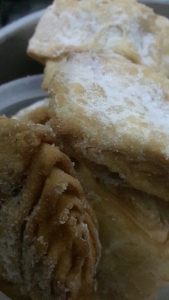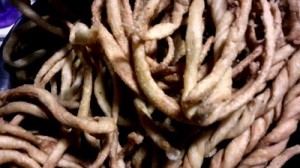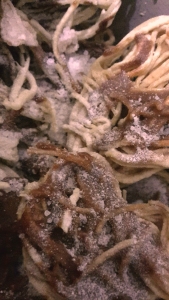With the Tibetan New Year or Losar around the corner (Thursday, in fact), I spent my Sunday in the kitchen, cooking Khapsey(s). A khapsey is a Tibetan snack or pastry, made of whole flour, sugar or salt and butter/ghee or oil; some varieties of khapseys are even topped with ground sugar or melted jaggery.
Khapsey literally translates into “mouth, eat” — meaning a snack to eat. With the help of my two Amalas — my own and my husband’s — we made a wide variety of Khapseys, mainly because they were giving in to my quest to make all the kinds of Khapseys made in the different regions of Tibet. (Here’s a great read on Tibetan Khabseys)
Of course, we made lots of different types of dough — colorful ones for the colorful khapseys; sweet ones for the rhug rhug or regular small khapseys; salty ones for the Bhungu Amjos or Donkey’s ears; Sichuan pepper-flavored, salty, oiled dough for the Amdo khapseys; and non-salted/non-sweetened ones for the Sangha Bhaley and Tseytang-Kotsay (two other types of khapseys that are topped with ground sugar and melted jaggery, respectively).
Here’s what we started off our Khapsey-making session with… the scorpion.

The scorpion is always the first Khapsey that goes into the wok full of hot oil. Made with the Khapsey dough, the scorpion is meant to take away all the bad luck and ills of the past year and any that may be prevalent during the khabsey-making session. Tibetans don’t eat this scropion-shaped Khapsey, but instead, they hang this near their stove in the kitchen. (There’s also the snake, but we didn’t make that this time)
Then the others followed… The Bhungu Amjo or the Donkey’s ears — Salty khapseys that are shaped like donkey’s ears and take pride of place in Tibetan altars as Losar decorations. They’re also lovely to have with Tibetan butter tea, or regular sweet tea.
The rhug rhugs are the regular sweet Khapseys. These are great to taste and easy to carry around during picnics or offer around when guests come visiting.
We also made the sugar-coated Sangha Bhaley — not too many of them because I was trying out the recipe for the first time. But it didn’t turn out too bad.
We followed that up with our version of the Amdo Khapseys, or Khapseys made in the Amdo region of Tibet. (We’re from Tsang, central Tibet; Amdo is in East Tibet).
And then of course, we made my favorite — the Tsey-tang Kotsay, which is spaghetti-pasta shaped khapseys that are topped with melted jaggery.
And after the day-long khapsey-making session, the three of us put them all away in cartons, until they will be unveiled for the altar decorations due later tonight.
Of course, we offered the first of the khapseys that came out of the hot oil to the Gods, what we Tibetans call “phue” or the offering of the first of anything. (Remember, my post on the first drops of the morning tea? More here.)
See you in the Wood-Sheep year!






Thanks for sharing I have a great affection for Tibet and the Tibetan people. Please tell me what are amalas?
LikeLiked by 1 person
Thanks Charlotte. It is due to the support of truth – loving people such as you that world leaders are forced to hear our cries.
LikeLike
Ama is mother. La is the honorific that we add at the end of people’s names to denote our respect for them. So Amala is mother. 🙂
LikeLike
Reblogged this on info4youonmexico.
LikeLike
Wow….. quite a a hard work. Reminds me of Indian New Year preparations. Happy New year in advance.
LikeLike